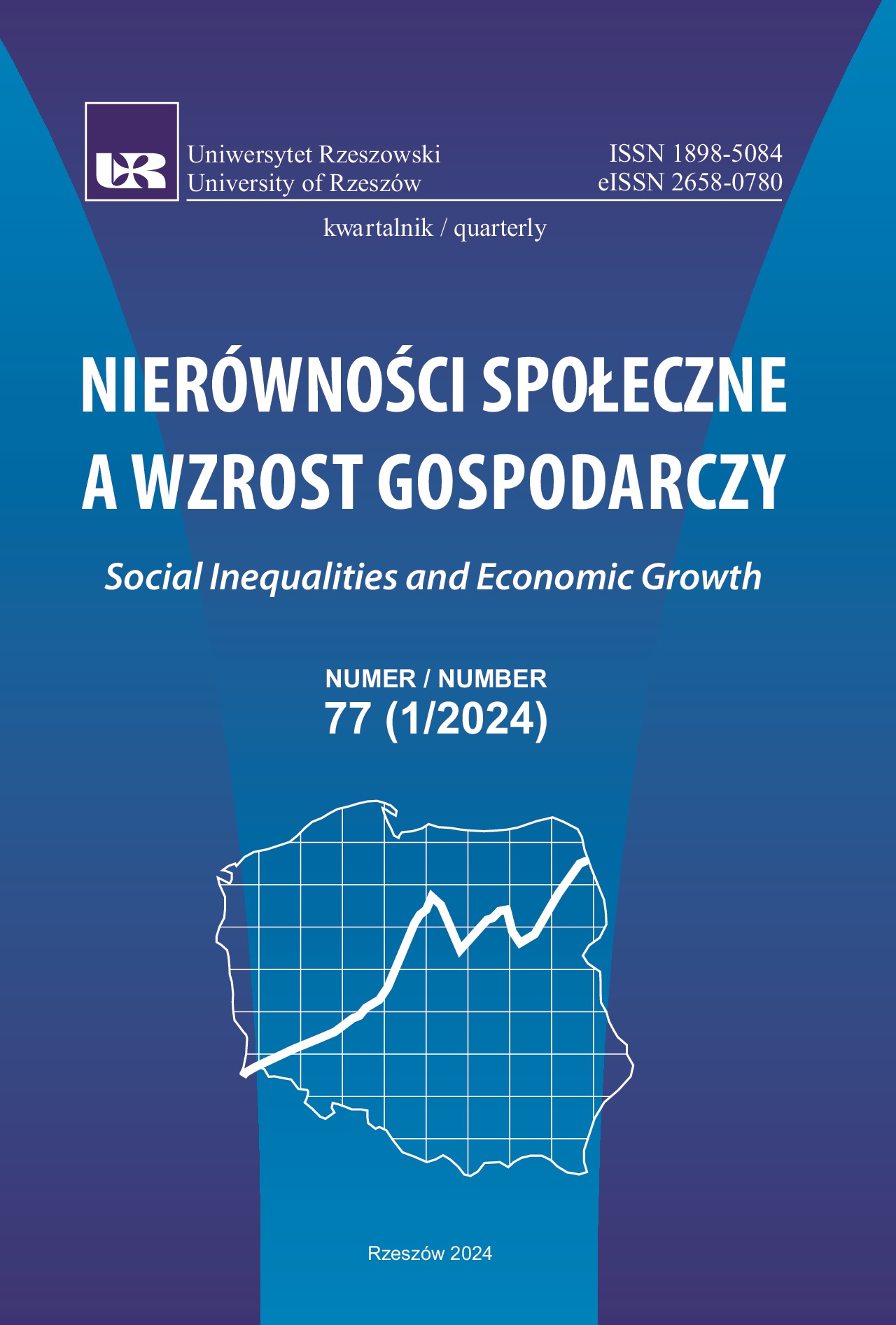PKB uwzględniający nierówności jako miara rozwoju gospodarczego
DOI:
https://doi.org/10.15584/nsawg.2024.1.1Słowa kluczowe:
PKB per capita, nierówności dochodowe, kraje UEAbstrakt
Celem artykułu jest wypracowanie metody pozwalającej korygować PKB per capita za pomocą miar nierówności dochodowych. Otrzymana w ten sposób wielkość PKB per capita skorygowana miarami nierówności dochodowych, pozwala na porównanie krajów UE pod względem wysokości tej nowej miary. Ustalenie pięciu grup krajów i wskazanie, jak zmieniły się relacje PKB per capita między nimi przed i po uwzględnieniu nierówności, jest istotną wartością dodaną tego artykułu. Zakres czasowy obejmuje lata 2005–2020. Zakres przestrzenny obejmuje kraje UE, czyli 28 krajów członkowskich, które w tym czasie znajdowały się w UE. Materiał statystyczny pozyskano w bazach danych Eurostat i OECD. Główna hipoteza sprowadza się do stwierdzenia, że nierówności dochodowe mają wpływ na rozwój gospodarczy mierzony tempem wzrostu PKB. Dla ilustracji i weryfikacji hipotezy posłużono się metodami statystycznymi: badaniem zmienności, korelacji, weryfikacji zmiennych, a także posłużono się metodami analizy logicznej, badaniem związków przyczynowo-skutkowych.
Ogólne wnioski z badania wskazują, że przedstawiona metoda korygowania PKB per capita jest pewną propozycją rozwiązania, nie wyczerpuje ona jednak wszystkich zagadnień i problemów, które towarzyszą uwzględnianiu nierówności dochodowych dla szacunków PKB. Ponadto interesujące wnioski w sferze aplikacyjnej pojawiają się, gdy nową miarę PKBN(d) wykorzysta się do
wyodrębnienia i porównywania grup krajów członkowskich, gdyż rankingi krajów uległy zmianie po skorygowaniu PKB nierównościami.
Downloads
Bibliografia
Arnold, F., Blochliger, H. (2016). Regional GDP in OECD countries: How has the inequality developed over time? OECD Economics Department Working Papers, 1329, 5–21. DOI: 10.1787/5jlpq7xz3tjc-en.
Balcerzak, A.P. (2011). Taksonomiczna analiza jakości kapitału ludzkiego w Unii Europejskiej w latach 2002–2008. Prace Naukowe Uniwersytetu Ekonomicznego we Wrocławiu. Taksonomia, 18(176), 456–467.
Banerjee, A., Duflo, E. (2003). Inequality and growth: What can the data say? Journal of Economic Growth, 8(3), 267–299. DOI: 10.3386/w7793. DOI: https://doi.org/10.1023/A:1026205114860
Barro, R.J. (2000). Inequality and Growth in a Panel of Countries. Journal of Economic Growth, 5, 5–32. DOI: 10.1023/a:1009850119329. DOI: https://doi.org/10.1023/A:1009850119329
Berg, A., Ostry, J.D., Tsangarides, C.G., Yakhshilikov, Y. (2018). Redistribution, inequality and growth: new evidence. Journal of Economic Growth, 23(3), 259–305. DOI: 10.1007/s10887-017-9150-2. DOI: https://doi.org/10.1007/s10887-017-9150-2
Clarke, G.R.G. (1995). More evidence on income distribution and growth. Journal of Development Economics, 47(2), 403–427. DOI: 10.1016/0304-3878(94)00069-o. DOI: https://doi.org/10.1016/0304-3878(94)00069-O
Ćwiek, M., Trzcińska, K. (2022). The economic situation of households in Poland and the Czech Republic. Comparative analysis. Nierówności Społeczne a Wzrost Gospodarczy, 72(4), 26–43. DOI: 10.15584/nsawg.2022.4.2. DOI: https://doi.org/10.15584/nsawg.2022.4.2
Dahlke, P. (2017). Samorząd terytorialny w procesie kształtowania rozwoju gospodarczego regionu na przykładzie województwa wielkopolskiego. Piła: Wydawnictwo Państwowej Wyższej Szkoły Zawodowej im. Stanisława Staszica w Pile.
Deininger, K., Olinto, P. (2000). Asset distribution, inequality and growth. Policy Research Working Paper, 2375, 1–29. DOI: 10.1596/1813-9450-2375. DOI: https://doi.org/10.1596/1813-9450-2375
Dominicis, I., Florax, R., Groot, H. (2008). A meta-analysis on the relationship between inequality and economic growth. Scottish Journal of Political Economy, 55(5), 654– 682. DOI: 10.1111/j.1467-9485.2008.00470.x. DOI: https://doi.org/10.1111/j.1467-9485.2008.00470.x
Forbes, K.J. (2000). A reassessment of the relationship between inequality and growth. American Economic Review, 90(4), 869–887. DOI: 10.1257/aer.90.4.869. DOI: https://doi.org/10.1257/aer.90.4.869
Grabiński, T. (1984). Wielowymiarowa analiza porównawcza w badaniach dynamiki zja¬wisk gospodarczych. Kraków: Wydawnictwo AE w Krakowie.
GUS. (2024). Pojęcia stosowane w statystyce publicznej Pobrane z: https://stat.gov.pl/ metainformacje/slownik-pojec/pojecia-stosowane-w-statystyce-publicznej/3077,po¬jecie.html (2024.01.08).
Gutierrez-Romero, R. (2020). Inequality affects long-run growth: Cross-industry, cross-country evidence. SSRN Electronic Journal, 1–41. DOI: 10.2139/ssrn.3592024. DOI: https://doi.org/10.2139/ssrn.3592024
Hussain, M.A., Greve, B. (2023). The possible impact of changes in demography on economic inequality in Europe. In: U.R. Wagle (ed.), Research Handbook on Poverty and Inequality (p. 245–267). Northampton: Elgar Handbook of Inequality. DOI: 10.4337/9781800882300. DOI: https://doi.org/10.4337/9781800882300.00021
Kornai, J. (2014). Dynamizm, rywalizacja i gospodarka nadmiaru. Kraków: Fundacja GAP.
Kośny, M., Peternek, P. (2011). Wielkość próby a istotność wnioskowania statystycznego. Didactics of Mathematics, 8(12), 71–80.
Kuznets, S. (1955). Economic Growth and Income Inequality. The American Economic Review, XLV(1), 1–28.
Li, H., Zou, H. (1998). Income inequality is not harmful for growth: theory and evidence. Review of Development Economics, 2(3), 318–334. DOI: 10.1111/1467-9361.00045. DOI: https://doi.org/10.1111/1467-9361.00045
Myrdal, G. (1973). Against the Stream. Critical Essays on Economics. London: Macmillan. DOI: 10.1007/978-1-349-02205-2_11.
Neves, P.C., Afonso, O., Silva, S.T. (2016). A meta-analytic reassessment of the effects of inequality on growth. World Development, 78, 386–400. DOI: 10.1016/j.worlddev.2015.10.038. DOI: https://doi.org/10.1016/j.worlddev.2015.10.038
OECD. (2008). Handbook on Constructing Composite Indicator. Methodology and user guide. Pobrane z: https://read.oecd-ilibrary.org/economics/handbook-on-constructing-composite-indicators-methodology-and-user-guide_9789264043466-en#page9 (2024.01.08).
Panizza, U. (2002). Income inequality and economic growth: evidence from American data. Journal of Economic Growth, 7(1), 25–41. DOI: 10.2139/ssrn.178708.
Piasecki, R. (2008). Ekonomia rozwoju wobec problemów nędzy i nierówności na świecie, Annales. Etyka w życiu gospodarczym, 11(1), 225–232. DOI: https://doi.org/10.18778/1899-2226.11.1.22
Piketty, T., Saez, E., Zucman, G. (2022). Twenty Years and Counting: Thoughts about Measuring the Upper Trail. The Journal of Economic Inequality, 20, 255–264. DOI: 10.1007/s10888-022-09536-8. DOI: https://doi.org/10.1007/s10888-022-09536-8
Polak, E. (2014). Rozwój zintegrowany a dobrobyt społeczno-ekonomiczny – kłopoty z pomiarem. Nierówności Społeczne a Wzrost Gospodarczy, 37, 5–19.
Poskrobko, T. (2012). Nowe koncepcje i teorie rozwoju w ekonomii. W: S. Czaja, A. Becla, J. Włodarczyk, T. Poskrobko, Wyzwania współczesnej ekonomii (s. 77– 118). Warszawa: Difin.
Raport „The Economist” (2012). Pobrane z: https://www.obserwatorfinansowy.pl/ (2023.09.26).
Sarama, M. (2012). Wybrane problemy tworzenia wskaźników złożonych w badaniach rozwoju społeczeństwa informacyjnego i gospodarki elektronicznej, Zeszyty Naukowe Uniwersytetu Szczecińskiego,702, „Ekonomiczne Problemy Usług”, 87, 345–353.
Słodowa-Hełpa, M. (2013). Rozwój zintegrowany. Warunki, wymiary, wyzwania. Warszawa: CeDeWu.
Solarin, S.A., Erdogan, S., Pata, U.K. (2023). Convergence of Income Inequality in OECD Countries Since 1870: A Multi-Method Approach with Structural Changes. Social Indicator Research, 166, 601–626. DOI: 10.1007/s11205-023-03080-2. DOI: https://doi.org/10.1007/s11205-023-03080-2
Stiglitz, J. (2016). Inequality and Economic Growth. The Political Quarterly, 86(S1), 134–155. DOI:10.1111/1467-923X.12237. DOI: https://doi.org/10.1111/1467-923X.12237
Tsounta, E., Suphaphiphat, N., Ricka, F., Dabla-Norris, E., Kochhar, K. (2015). Causes and Consequences of Income Inequality. Staff Discussion Notes, 15(3), 1–39. DOI: 10.5089/9781513555188.006. DOI: https://doi.org/10.5089/9781513555188.006
UNDP. (2020). Human Development Report 2020: The Next Frontier: Human Development and the Anthropocene. New York: UNDP.
Woźniak, M.G. (2004). Wyznaczniki prowzrostowej strategii ograniczającej nierówności społeczne wynikające z teorii wzrostu. Nierówności Społeczne a Wzrost Gospodarczy, 4, 77–87.
Wójcik-Żołądek, M. (2013). Nierówności społeczne w Polsce. Infos, Biuro Analiz Sejmowych, 20(157), 1–4.
Pobrania
Opublikowane
Jak cytować
Numer
Dział
Licencja
Prawa autorskie (c) 2024 Uniwersytet Rzeszowski

Utwór dostępny jest na licencji Creative Commons Uznanie autorstwa – Użycie niekomercyjne – Bez utworów zależnych 4.0 Międzynarodowe.


